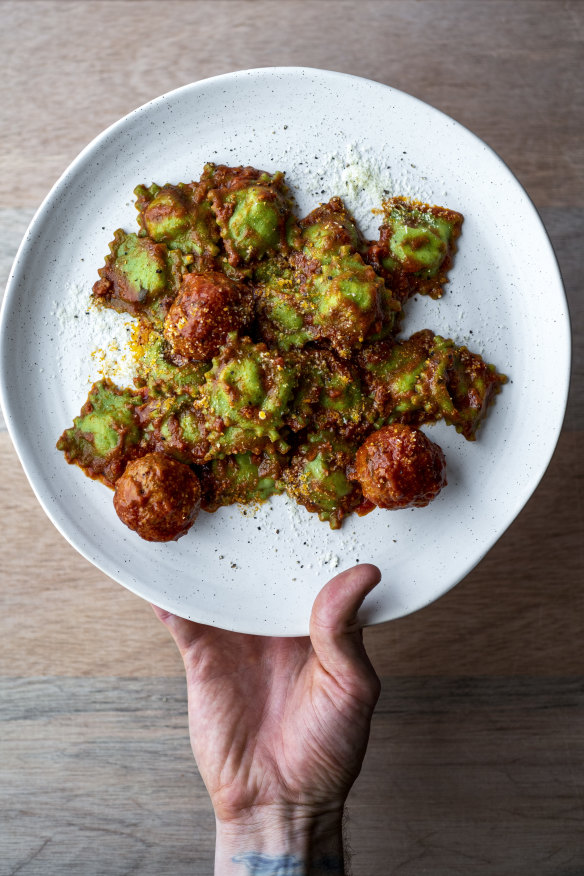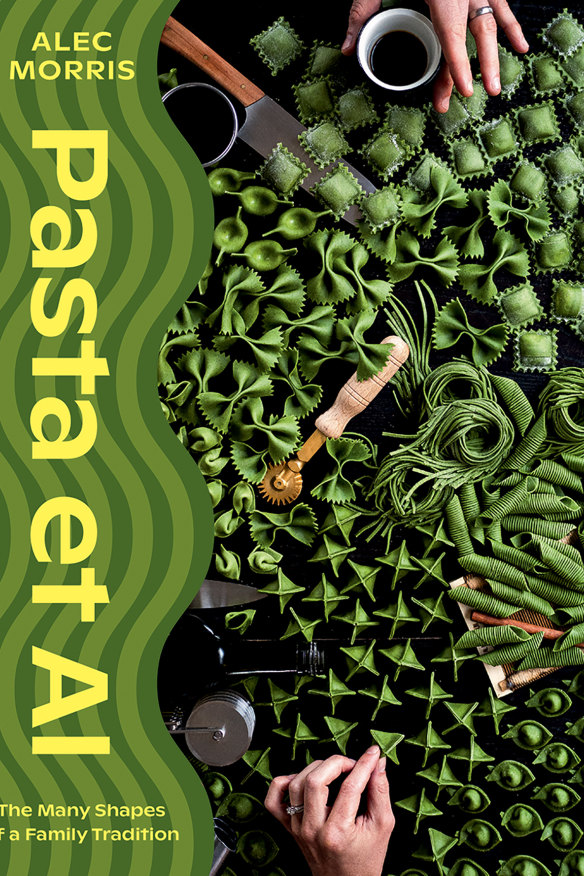Nonna’s secret recipe: How to make fresh spinach and ricotta ravioli from scratch
Food blogger Alec Morris of Pasta et Al was taught how to cook fresh pasta by his nonna as a child. Her vibrant weekly dish became the family’s signature recipe, and now you can make it too.
These days I make all kinds of pasta with all kinds of dough, but when I was a kid, there were only a few types that ever made it to the table. Don’t get me wrong, we enjoyed a little extra variety in the occasional packet pasta – secretly but unanimously excited as my nonna apologised for the rigatoni she was opening – but when we did it ourselves, our repertoire was deliberately and appropriately limited. We made spinach and ricotta ravioli, always with spinach dough, and we made spinach fettuccine with the leftovers. On occasion, we’d roll out some plain dough lasagne, sometimes gnocchi, but for the most part we were a green pasta family. To this day, the only dough that truly tastes “right” to me is freshly made spinach.

As the oldest grandchild, I’d mostly graduated from nonna’s scuola di cucina (or at least been finally expelled) by the time my brother and cousins arrived to bolster the workforce. But in the years before school, and on the weekends until they could passably turn a pasta handle, I would stand for hours beside my nonna churning out ludicrous amounts of pasta for the extended family, usually to last months at a time. And months at a time, in an Italian family, equates to a significant amount of pasta.
I don’t mean to claim any sort of mystical pasta knowledge gleaned from a childhood spent staring into pasta sheets, but it did teach me how to cook by taste and feel. Nonna’s “recipes” were along the lines of “you put flour in a bowl and mix in eggs”. And it certainly taught me how to make spinach and ricotta ravioli. In many ways, pasta for me started from and continues with this recipe, typically served with nonna’s sugo, meatballs on the side.
EQUIPMENT
- pasta machine
- ravioli mould/tray
- piping bag and medium round tip (optional)
- rolling pin

Spinach and ricotta ravioli with sugo and meatballs
INGREDIENTS
Spinach pasta dough
- 260g 00 flour, plus up to another 80g to allow for water left in the spinach
- 140g durum semolina flour
- 200g (4 cups) fresh baby spinach leaves, blanched, thoroughly drained and pureed (after blanching, this will reduce to about 90g, so substitute accordingly if using frozen spinach)
- 3 eggs
- 1 egg yolk
- 1 tbsp extra-virgin olive oil
- ½ tsp salt
Ravioli filling
- 400g fresh ricotta
- 100g (2 cups) fresh baby spinach leaves, blanched, thoroughly drained and chopped (after blanching, this will reduce to about 50g (1 cup), so substitute accordingly if using frozen spinach)
- 1 egg
- 25g pecorino romano, grated, or similar hard cheese, plus extra to serve
- salt and freshly cracked black pepper, to taste
Sugo
- ½ onion, diced
- ½ garlic bulb, minced
- 100ml extra virgin olive oil, or more if you want to really treat yourself
- 1 small handful of basil
- 700ml passata (pureed tomatoes)
- ½ tsp sugar
- salt and freshly cracked black pepper, to taste
Meatballs
- 250g minced pork
- 250g minced veal or beef
- 45g breadcrumbs, or one large slice of bread soaked in milk and squeezed
- 25g pecorino romano, grated
- 1 egg
- 1 small handful of parsley, finely chopped
METHOD
To make the ravioli
- Begin by forming a well with the 00 flour, durum semolina flour, and salt; either on a clean benchtop, or in a large mixing bowl. I often use the underside of a bowl to press down and hollow out the well’s centre. Place all wet dough ingredients into the centre.
- Use a fork or your fingers to stir, gradually incorporating the flour until you’re left with a shaggy ball. A bench scraper is particularly handy for keeping it all together at this stage. If your dough is too wet, add flour one tablespoon at a time; if too dry, run your hands under the tap and knead in the extra moisture.
- Once your dough holds together without sticking to your hands or work surface, knead it vigorously for 10 minutes. I find that it turns softer and silkier at around 7 minutes, but throw in an extra three to be sure. To knead, stretch the dough down and away from you with the heel of your hand, before folding it back over itself and repeating. Rotate it occasionally to avoid it stretching out too long.
- After 10 minutes of pummelling that dough like nonna, flatten it slightly into a thick disc and seal tightly in plastic wrap. Rest (yourself, and the dough) for 30 minutes away from heat or direct sunlight before moving on.
- While you wait, mix all of the ravioli filling ingredients together and transfer to a piping bag fitted with a medium round tip. You can easily use a bag without the tip, or even substitute with a teaspoon, but I find these methods less efficient when producing large batches of filled pasta.
- Unwrap the dough and flatten it out slightly before rolling it through the thickest setting on your pasta machine a few times, folding it over itself in between passes. It should take on a more consistent texture after a few repetitions. You’ll need to cut it into shorter lengths as you go. If you find it catches, lay the sheets out on a wooden board for a few minutes to lose the tackiness, or dust lightly with semolina.
- Incrementally step through the settings on your machine, thick to narrow, until you reach a thickness of about 1mm. Cut into sheets of appropriate length to cover your ravioli mould.
- Lightly flour one side of a sheet, and place it flour-side down on your mould. Press lightly with your fingertips so that the underlying pattern becomes visible.
- Pipe or spoon in your filling, and cover with another pasta sheet. If you’re working with a larger mould that requires more than one sheet, ensure there’s an overlap of dough and use a light brush of water in between to help them stick together.
- Lightly flour, and roll firmly with a rolling pin. You should see the mould cutting through the dough, and any joined pieces separating. Turn the mould over and knock the ravioli free by gently tapping the mould on your work surface. Transfer to baking paper-lined trays, lightly dusted with semolina, and refrigerate uncovered until ready to cook.
To make the sugo
- To a large cold pot, add the onion and half of the minced garlic with the olive oil. Set over a very low heat and stir gently but continuously for 25-30 minutes until the onion is sweaty and translucent. Do not let it brown. It can help to occasionally turn the heat off altogether and let it sit for a few minutes before continuing.
- Bruise the basil in your hand then add to the pot, frying gently for 2-3 minutes. Pour in the passata, then half-fill the bottle with water. Slosh it around to collect any remaining tomato, then add to the pot. Season the sauce with the sugar and a good pinch of salt, stir, then increase the heat to medium.
To cook the meatballs
- Place the pork and beef mince in a large bowl with the breadcrumbs, grated cheese, egg, the remaining minced garlic (from the sugo), parsley and a seasoning of salt and pepper. Knead together with your hands, allowing the mix to squeeze through your fingers. Break off plum-sized balls, then roll, turn and squeeze them into smooth meatballs using your palms. Transfer to a baking tray lined with baking paper and refrigerate until required.
- Once the sauce is at a gentle boil, drop the raw meatballs straight in. Try to avoid stirring with a wooden spoon until they’ve firmed up; instead, occasionally shuffle the pot gently by the handles for the first few minutes. Set over a low heat and cook for at least 3.5 hours, with the lid slightly ajar. We prop it open with the handle of a wooden spoon. Stir regularly, keeping an eye on the liquid levels and making sure that it doesn’t catch. If it becomes too dry, top it up with water and lower the heat further. You’ll know that it’s ready once the sugo has turned a dark red with oily puddles on top.
To serve
- To cook the ravioli, drop them into lightly salted and vigorously boiling water; cook until still firm but with no raw white dough visible when cut into, about 4-5 minutes. Lift the meatballs out of the pot, to be served separately, and stir the ravioli directly into the sauce. Serve with some extra grated pecorino.

This is an edited extract from Pasta et Al by Alec Morris, published by Hardie Grant Books, RRP $49.99. Buy now
The best recipes from Australia's leading chefs straight to your inbox.
Sign up